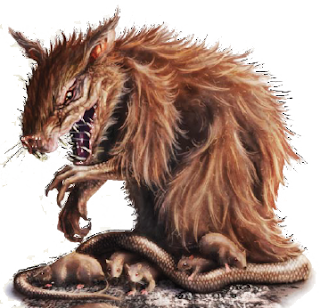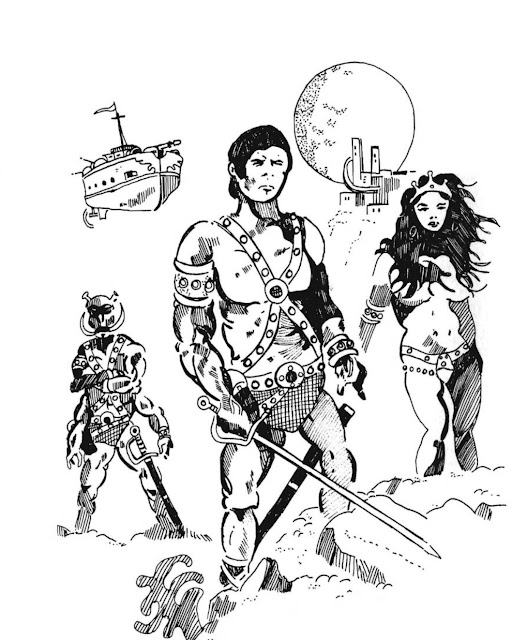Reconstructing The Giant Rat for OD&D
The Giant Rat is one of those creatures mentioned in Original D&D books but no stats were ever really given for it until Advanced D&D when the Monster Manual was published. Between the publication of OD&D and the publication of the Monster Manual many of the monsters went through changes, some became more powerful or hard to kill while others became easier for players to deal with. In addition many monsters had Alignment changes as D&D further expanded it’s alignment system.
Thankfully though there are some clues in the materials published for OD&D that can help us reconstruct the mighty and fearsome Giant Rat!
The first clue comes from Monsters & Treasure Volume 2 Of Three Booklets page 20:
“LARGE INSECTS OR ANIMALS: This category includes giant ants and prehistoric monsters. Armor Class can be anything from 8 to 2. Hit Dice should range from 2 to anywhere near 20, let us say, for a Tyrannosaurus Rex. Also included in this group are the optional “Martian” animals such as Apts, Bantus, Thoats, etc. If the referee is not personally familiar with various monsters included in this category, the participants of the campaign can be polled to decide all characteristics. Damage caused by hits should range between 2-4 dice (2-24 points).”
We learn several things from this quote, one the DM was expected to decide how many hit die and how much damage the envisioned large/giant creature could take and inflict and the rest of the play group could help with this as well. We also get a list of “Martian” animals from Edgar Rice Burroughs Martian Barsoom books. I will do a separate post on them as some did make it into D&D under different names but they also appear in another TSR game. As you can see as referee the game encouraged you to develop creature characteristics as you needed them. We also learn that the low end for damage and hit die is 2.
Clue number two occurs on page 4 of the same book the Monster Reference Table lists Large Insects or Animals as Number Appearing 2-16 and Armor Class as Variable with all other categories dotted out, which to me indicates the referee has to decide Move in Inches, Hit Dice, % In Lair, and Type or Amount of Treasure.
Clue number three Monster Level Tables on page 10 of The Underworld & Wilderness Adventures Volume 3 Of Three Booklets clearly list the Giant Rat as a monster appropriate for all levels of the dungeon. The Giant Rat appears in a table with Kobolds, Goblins, Skeletons, Orcs, Centipedes, Bandits and Spiders. This clue gives us an idea of the threat level if you will of this creature to player characters based on the other creatures in the table. So going back to Monsters & Treasure Volume 2 Of Three Booklets we can see Kobolds are 1/2 hit dice monster, Goblins are similarly a low hit monster 1-1 die, Orcs are 1 die monsters with Armor Class ranging from 6/7 to 6. The Skeltons are 1/2 hit die with Armor Class 7 as well. Bandits are 1 die guys as well, though some exceptional ones may be in the mix. Centipedes and Spiders again do not really have their own listing but are covered under Insects or Small Animals and based on that entry probably are 1 hit point critters and have an AC of 8 or maybe even 9. Based on this alone I would be inclined to assign the Giant Rat no more than 1 hit die, however this is a Giant Rat not a large rat.
There is one early published dungeon Palace of the Vampire Queen which lists Giants Rats as a monster players might have to deal with and looking at the assigned hit point for two different Giant Rats of 9 and 11 I can safely surmise the Giant Rats in that barebones OD&D dungeon were in fact 2HD monsters just as Monsters & Treasure said to make them.
Finally the much later Monster Manual though lists them as a small creature and clearly also down sized their toughness by giving them 1-4 hit points! I just don't imagine them at all that way, from best I can tell how I always imagined a Giant Rat to be did at a very much later date become the Dire Rat and at some early point the Giant Rat got downsized to something akin to a folkloric New York Sewer Rat, big for a rat yes but not actually giant. So what is a referee to do?
Well, I am personally treating the Giant Rat as a 2 hit dice monster it's big, it's nasty and Large Rats would by 1 hit die, with regular rats being 1 hit point critters. I think there is sufficient indication in old rules and what little published material I could find to see these as much larger and nastier than they became in AD&D. Based on the comment on page 20 of Monsters & Treasure concerning a regular wolf's armor class being 8 I decided it was unlikely the Giant Rat would be better than that. I then compared the Monster Manuals Treasure Table to Monsters & Treasures Treasure Table and though there are differences I decided to go with the Monster Manual suggested C. Now disease is not mentioned in the old material I have for the Giant Rat, but disease rules do occur in Supplement II Blackmoor on pages 52-54. The Blackmoor rules leave it up to the Dungeon Master to decide if the Player Characters are being exposed to a disease and which disease. As a result though rats of any size can carry disease it is really up to the referee if said monsters are or if some activity the players are doing say rummaging through a Giant Rat lair of filth for treasure is exposing them to disease. So the following stats reflect my thinking on how Giant Rats should be.
The Giant Rat
No. Appearing 2-16
Alignement: Neutrality
Movement: 12"/6"
Armor Class: 8
Hit Dice: 2
Attacks: 1
Damage: 1d6
Save: F2
% In Lair: 10%
Treasure Type: C
I pretty much envision my Giant Rats as large dog sized rodents. They may or may not carry disease. They can be found underground and above ground.





Comments
Post a Comment